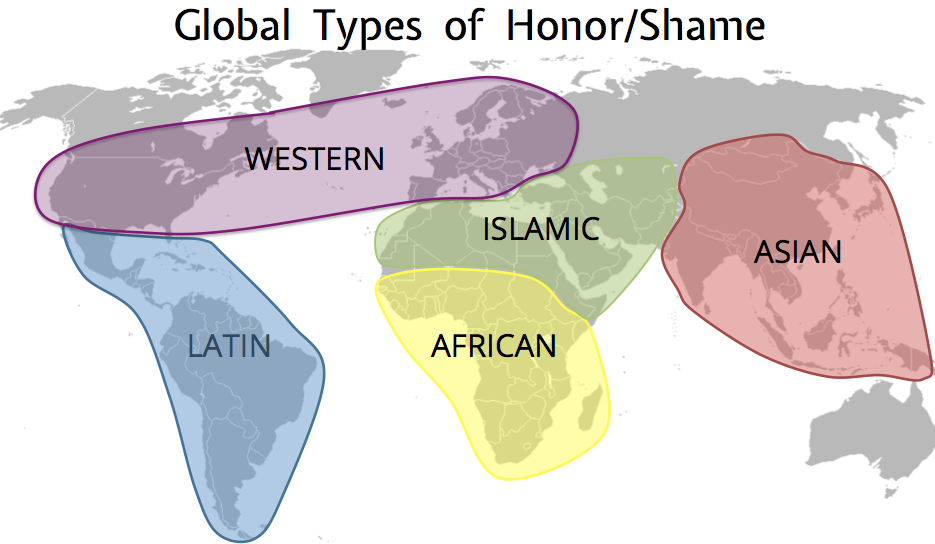5 Types of Honor-Shame Cultures
Q: What do honor-shame cultures and wine have in common? A: They both have terroir!
Honor and shame cultures always have a unique flavor depending on the context. For example, East Asians response to shame by withdrawing, whereas Middle Easterners will defend their honor aggressively.The values of honor and shame lead to antithetical responses. Codes of honor and shame vary so widely that some scholars insist on using the plural “honors,” implying there is no singular, universally-shared notion of “honor” or “shame.” Here is how I explain it:
Honor and shame are the foundational values of many cultures, but every culture expresses those values uniquely. Every culture has its own flavor of honor and shame.
Alexis de Tocqueville made a similar observation when visiting America:
What our fathers called the archetype of honor was, in reality, only one of its forms. They gave a generic name to what was only a species. Honor is to be found therefore in democratic centuries as well as in aristocratic times. But it will not be hard to show that in the former it presents a different face. (Democracy in America [1848] 4:152-53)
To illustrate this reality, I broke down the 5 major types of honor/shame: Western, Latin, Islamic, African, and Asian. 
Explanation of the 5 Regions of Honor-Shame
- Western shame tends to be more private and personal. It is an internal, psychological emotion often rooted in the fragmentation and alienation of modern life. Shame is not so much community scorn (though social media is bringing this aspect out more and more), but low self-esteem. Read more.
- Latin notions of honor, at least for men, often depend upon being macho. Honor-shame are uniquely linked to race and economic class in South American. Read more. Recall also that the countries of southern Europe are Latin-based, so share some similarities.
- Islamic culture highly esteems the Koran, Mohammed, the ummah, and even the Arabic language, as symbolic representations of honor. Muslims feel personally disrespected if any of these are disgraced. Middle Eastern cultures tend to compete aggressively for honor, so can feel justified using violence to defend their honor (i.e., honor killings, terrorism).
- African cultures give a high value to ancestry and have a strong community orientation. Properly honoring the living dead is a crucial part of African religion/culture.
- In Asian cultures, the notion of “face” is paramount. One can lose, keep, save, and gain “face.” People’s response to shameful situations tends to be more passive, because shaming someone else brings shame upon oneself, hence the extreme politeness.
The above comments are obviously broad generalizations. Such simplifications will make some cringe, and rightfully so. I lived in Central Asia for nine years, where the culture is a unique amalgamation of Islamic, Asian, and Soviet notions of honor-shame. Culture types are far more complex than the above map implies.
The point here is simply this: honor-shame has unique flavors; honor-shame is not monolithic. A more accurate depiction would break out the thousands honor-shame flavors, but that becomes too unwieldy to be practically helpful. How would you explain the terroir of honor-shame in your context?

Great post. This is a critical point to the entire conversation. Every culture is, technically, an “honor & shame” culture as every culture has various types of honor and shame expressions/mechanisms. The trick is to learn the “somewhereness”, the goût de terroir, as you put it, of each expression. Great stuff!
Sorry Aussies for my exclusionary cartography. Rest assured, God sees you..even down under! 🙂
I really appreciate the insight into the distinction of honor shame in Latin America. Often this world view is discussed in the context of Muslim cultures. The included link to more information specific to Latin America via Mission Frontiers was very valuable.
I agree with Chris. Nice helpful post. Thanks.
Very fascinating and helpful delineation.
I’d also be curious to learn more about how these elements interact and overlap; i.e. are some elements more dominant? more subtle? What happens when different notions of honor “bump into” each other? For example: I’m from southern California – Latin/Western borders. I live among Muslims in East Asia – Asian/Islamic borders. And I have lots of classmates who come from Nigeria – Islamic/African borders. Perhaps in a place like Turkey you’d have more Western/Islamic overlap.
Thanks for the post!
Josh, those are certainly all the right questions. Unfortunately, they are hard questions to answers.
Cultures do blend and meld, so the only people who can explain local honor codes are people living in that context. One reality is that every person navigates between multiple “honor-shame cultures” every day (some say, “every conversation”) without realizing it, so explanations are at best generalizations.
I’m just trying to point the fact of this reality, not explain how it happens in every spot.
-Jayson
Not sure if you’d want to update the graphic, but as one living in Mongolia who has worked with folks from eastern Siberia, you can extend that pretty much straight north. Wish I could speak to Alaska for you. I do know friends, however, who have done work with the Native peoples of Alaska and with people groups in northeastern Siberia who say the groups are very similar culturally.